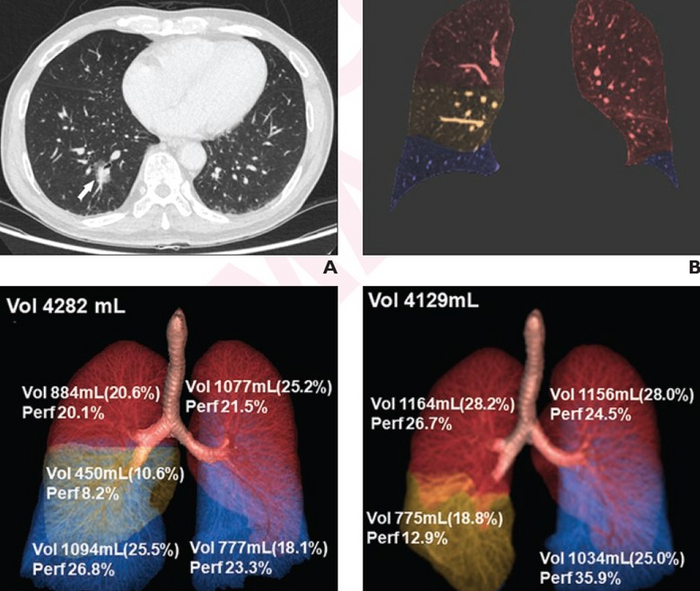Leesburg, VA, November 2, 2022—According to an accepted manuscript published in ARRS’ American Journal of Roentgenology (AJR), metrics derived from dual-energy CT (DECT) can provide insight on physiologic changes after lung cancer surgical resection, beyond the information provided by pulmonary function tests (PFTs) and conventional CT.

Credit: ARRS, AJR
Leesburg, VA, November 2, 2022—According to an accepted manuscript published in ARRS’ American Journal of Roentgenology (AJR), metrics derived from dual-energy CT (DECT) can provide insight on physiologic changes after lung cancer surgical resection, beyond the information provided by pulmonary function tests (PFTs) and conventional CT.
“DECT depicts patterns of lung volume and perfusion changes after lung cancer surgery, depending on surgical approach (lobectomy vs. limited resection) and tumor lobar location,” wrote corresponding author Young Jin Kim, MD, PhD, from the Research Institute of Radiological Science at Korea’s Yonsei University College of Medicine.
In this AJR accepted manuscript, 81 patients (38 men, 43 women; mean age, 60.5 years; lobectomy in 43, limited resection in 38) awaiting lung cancer resection surgery between March 2019 and February 2020 were included. Patients underwent thoracic DECT and PFT evaluation preoperatively and 6 months postoperatively. Pulmonary lobes were segmented, and lobar volume and perfusion ratios—both relative to whole-lung values—were computed. Perfusion measures reflected DECT-derived iodine content. Patients then completed 6-month postoperative quality-of-life questionnaires.
Ultimately, lung perfusion ratio increases were greater after lobectomy than limited resection for ipsilateral nonresected lobe(s) (39.9±20.7% vs 22.8±17.8%) and contralateral lung (20.9±9.4% vs 4.3±5.6%). After right lower lobe lobectomy, the largest postoperative increases in lung volume ratio occurred in the right middle lobe (44.1±21.0%), whereas the largest postoperative increase in lung perfusion ratio occurred in the left lower lobe (53.9±8.6%).
Noting some postoperative changes in DECT-derived volume and perfusion parameters showed a correlation with patient-reported postoperative quality-of-life scores, “the findings indicate a potential role of DECT-derived metrics for understanding the variable physiologic impacts of lung cancer resection surgeries,” the authors of this AJR accepted manuscript reiterated.
An electronic supplement to this AJR accepted manuscript is available here.
North America’s first radiological society, the American Roentgen Ray Society (ARRS) remains dedicated to the advancement of medicine through the profession of medical imaging and its allied sciences. An international forum for progress in radiology since the discovery of the x-ray, ARRS maintains its mission of improving health through a community committed to advancing knowledge and skills with the world’s longest continuously published radiology journal—American Journal of Roentgenology—the ARRS Annual Meeting, InPractice magazine, topical symposia, myriad multimedia educational materials, as well as awarding scholarships via The Roentgen Fund®.
MEDIA CONTACT:
Logan K. Young, PIO
44211 Slatestone Court
Leesburg, VA 20176
703-858-4332
Journal
American Journal of Roentgenology
DOI
10.2214/AJR.22.28450
Method of Research
Imaging analysis
Subject of Research
People
Article Title
Patterns of Postoperative Changes in Lung Volume and Perfusion Assessed by Dual-Energy CT: Comparison of Lobectomy and Limited Resection
Article Publication Date
2-Nov-2022




